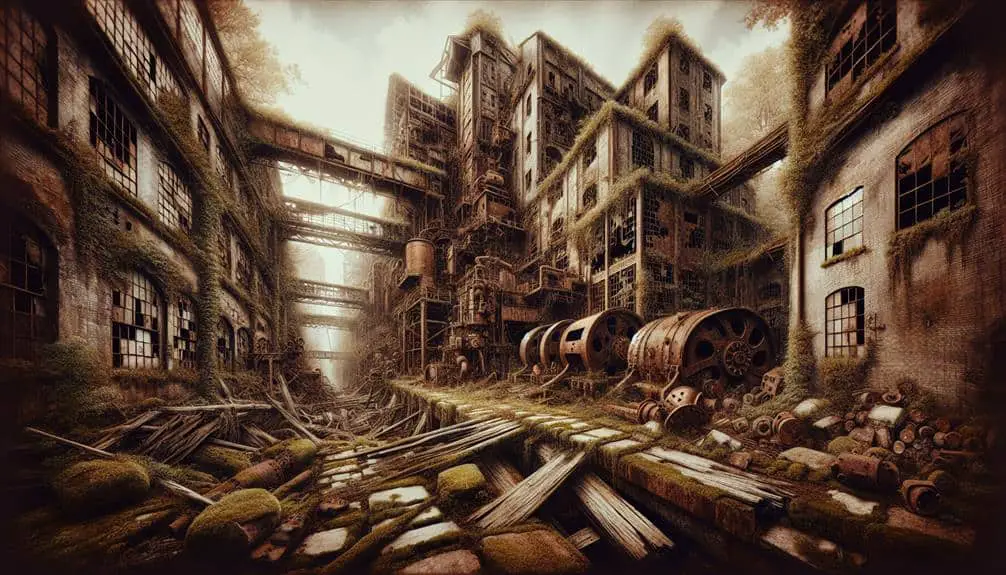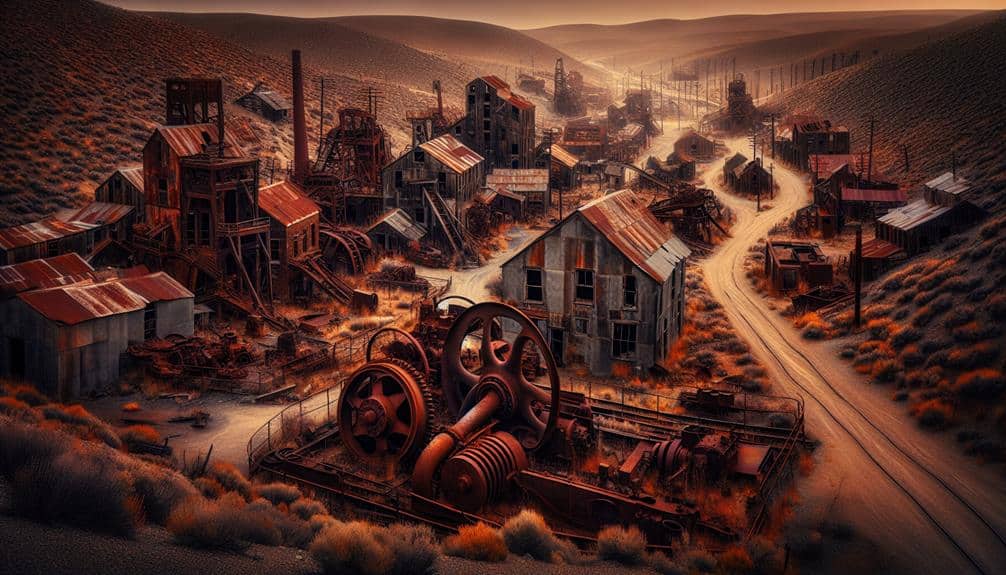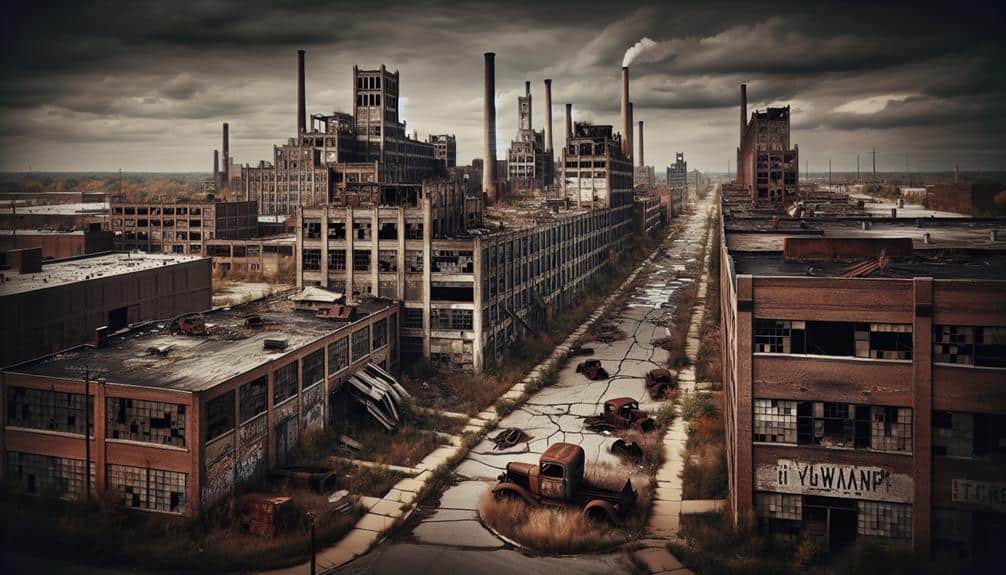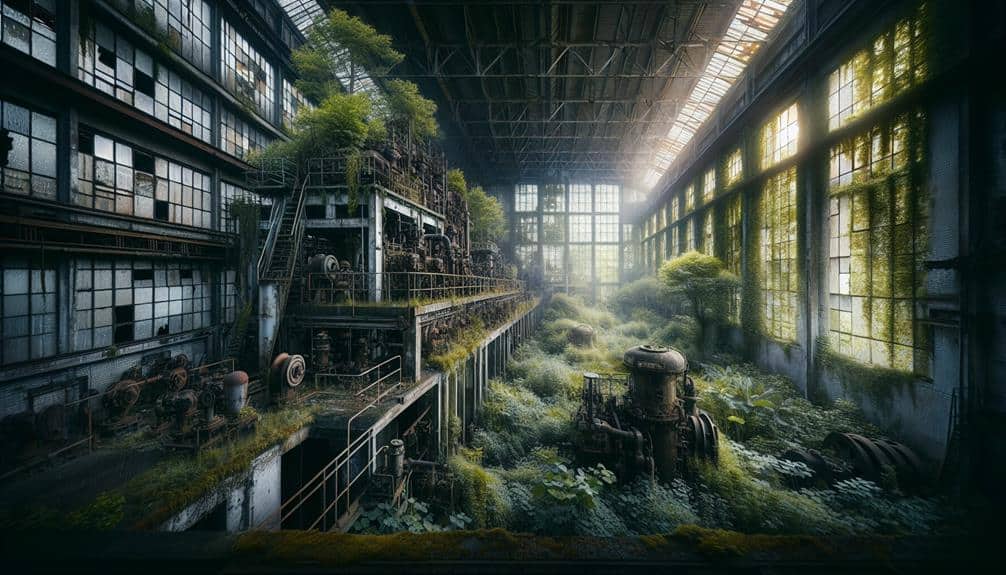American industrial settlements declined due to economic shifts, technology advancements, and changing preferences. Environmental degradation, resource depletion, and modernization played roles. Economic changes caused job loss, urbanization, and population decline. Preservation efforts now protect these sites for historical tourism, showcasing the interconnectedness of economy, society, and environment. Lessons from these abandoned towns reveal the impact of past mistakes and unsustainable practices, offering insights into our economic and societal structures.
Key Points
- Economic shifts and technological advancements led to decline in industrial settlements.
- Environmental degradation and resource depletion made settlements unsustainable.
- Job displacement and urbanization trends contributed to population decline.
- Preservation efforts and historical tourism initiatives aim to safeguard industrial sites.
- Lessons on economic fragility, societal resilience, and environmental impact learned from abandoned towns.
Rise of American Industrial Settlements
During the late 19th century, the proliferation of American industrial settlements reshaped the economic landscape of the nation, establishing hubs of manufacturing and innovation. Innovation was at the forefront of this era as new technologies and production methods revolutionized industries, leading to unprecedented growth and expansion. American industrial settlements became beacons of progress, attracting skilled workers and entrepreneurs enthusiastic to be part of this industrial revolution.
The expansion of these settlements was rapid and extensive, fueled by a combination of factors such as abundant natural resources, improved transportation networks, and a growing market demand for goods. As these settlements grew, they not only transformed the physical geography of the regions but also played a pivotal role in shaping the social and cultural fabric of American society.
The spirit of innovation that characterized these industrial settlements laid the foundation for the modern industrial economy, setting the stage for the technological advancements and economic prosperity that would follow in the decades to come.
Factors Leading to Abandonment
The decline of American industrial settlements can be attributed to a combination of economic shifts, technological advancements, and changing consumer preferences. Environmental degradation played a significant role in the abandonment of these settlements. Industries often left behind a trail of pollution and ecological damage, making the areas less habitable over time. Resource depletion also contributed to their downfall. As industries exploited natural resources for production, they often depleted these reserves to unsustainable levels, leading to economic instability and eventual abandonment of the settlements.
Moreover, advancements in technology played a vital role. As industries modernized and automated their processes, they required fewer manual workers, leading to a decline in employment opportunities in these settlements. This, coupled with changing consumer preferences for more sustainable and environmentally friendly products, further accelerated the abandonment of these industrial areas. To sum up, the combination of environmental degradation, resource depletion, technological advancements, and shifting consumer demands all played key roles in the abandonment of American industrial settlements.
Impact of Economic Changes
Economic changes greatly influenced the trajectory of American industrial settlements, shaping their development and ultimately contributing to their decline. Job displacement played a significant role in the abandonment of many industrial settlements. As industries evolved and technology advanced, the demand for certain jobs decreased, leading to widespread unemployment in these settlements. This economic shift forced many residents to seek job opportunities elsewhere, leaving behind the once-thriving industrial communities.
Moreover, urbanization trends also impacted these settlements. As cities expanded and urban areas grew, industrial settlements located in more remote or less economically viable locations struggled to compete. The migration of people towards urban centers resulted in a decline in population in these industrial settlements, further exacerbating their economic challenges. This shift towards urbanization led to a decrease in resources and services available in these areas, making them less desirable for both residents and businesses.
Preservation Efforts and Tourism
Efforts to preserve and promote industrial settlements as tourist destinations have gained momentum in recent years. Preservation initiatives aim to safeguard the historical significance of these sites, allowing visitors to step back in time and experience the industrial heritage of America. By restoring old factories, mills, and worker housing, these initiatives provide a glimpse into the past, showcasing the importance and hard work of previous generations.
Historical tourism plays a crucial role in sustaining these preserved settlements. Tourists are drawn to these sites to learn about the industrial revolution, the daily lives of workers, and the impact of industrialization on society. By offering guided tours, interactive exhibits, and educational programs, these destinations bring history to life and create immersive experiences for visitors.
As more industrial settlements are preserved and opened to the public, the significance of maintaining these historical sites becomes increasingly evident. Through ongoing preservation efforts and the promotion of historical tourism, these once-lost American industrial settlements are being revitalized and celebrated for their contributions to the country's industrial development.
Lessons From Lost Industrial Towns
Exploring the remnants of abandoned industrial towns provides valuable insights into the impact of economic shifts and societal changes on once-thriving communities. These ghost towns stand as evidence to the rise and fall of industries, showcasing the fragility of economic structures and the resilience of communities. Amidst the decaying buildings and rusting machinery, lessons emerge on the importance of community resilience in the face of adversity.
The historical significance of these lost industrial settlements can't be overstated. They serve as reminders of past mistakes, cautionary tales about the consequences of unsustainable practices. By studying these abandoned towns, one can gain a deeper understanding of the interconnectedness of economy, society, and environment. The echoes of prosperity and decline resonate through the empty streets, prompting reflections on the cyclical nature of progress and regression.
In unraveling the stories of these lost industrial towns, one uncovers valuable insights that transcend time and place. The lessons learned from their demise serve as guideposts for maneuvering the complexities of modern society, emphasizing the importance of adaptability, foresight, and community cohesion.
Frequently Asked Questions
What Role Did Natural Disasters Play in the Abandonment of Industrial Settlements?
Natural disasters often contributed to the abandonment of industrial settlements, exacerbating economic downturns. These calamities, ranging from floods to fires, disrupted production, destroyed infrastructure, and displaced workers, leading to the decline of these communities.
How Did Social Issues, Such as Labor Disputes, Contribute to the Decline of These Settlements?
Labor strikes, a euphemism for social friction, disrupted harmony within industrial settlements. Community dynamics shifted as disagreements escalated, leading to the decline of these once-thriving areas. The impact of labor disputes on settlement prosperity cannot be understated.
Were There Any Environmental Factors That Led to the Abandonment of Industrial Towns?
Urban decay and pollution effects led to the abandonment of industrial towns. Environmental degradation, like toxic waste and air pollution, made these settlements inhospitable. Neglect of infrastructure and contamination played a significant role in the decline of these areas.
What Impact Did Technological Advancements Have on the Downfall of These Settlements?
Embrace the wisdom: "Out with the old, in with the new." Technological advancements revolutionized industries, altering workforce needs and efficiency. As machines replaced manpower, many settlements couldn't adapt, leading to their downfall and abandonment.
How Did the Changing Demographics of the American Population Affect the Sustainability of Industrial Towns?
As the American population shifted, the changing workforce and economic shifts influenced the sustainability of industrial towns. Demographic transformations altered the labor pool and consumer base, impacting the viability of these settlements over time.



